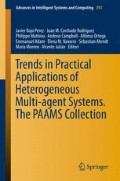Abstract
This paper presents an autonomous agent for gas leak source detection. The main objective of the robot is to estimate the localization of the gas leak source in an indoor environment without any human intervention. The agent implements an SLAM procedure to scan and map the indoor area. The mobile robot samples gas concentrations with a gas and a wind sensor in order to estimate the source of the gas leak. The mobile robot agent will use the information obtained from the onboard sensors in order to define an efficient scanning path. This paper describes the measurement results obtained in a long corridor with a gas leak source placed close to a wall.
Access this chapter
Tax calculation will be finalised at checkout
Purchases are for personal use only
Preview
Unable to display preview. Download preview PDF.
References
Woosub, L., Sungchul, K., Munsang, K., Mignon, P.: ROBHAZ-DT3: teleoperated mobile platform with passively adaptive double-track for hazardous environment applications. In: 2004 IEEE/RSJ International Conference on Intelligent Robots and Systems (IROS), Sendai, Japan, vol. 1, pp. 33–38 (2004)
Trindade, N., Antunes, L.: An Architecture for Agent’s Risk Perception. Advances in Distributed Computing and Artificial Intelligence Journal 1(5), 75–85 (2013)
Guivarch, V., Camps, V., Péninou, A.: AMADEUS: an adaptive multi-agent system to learn a user’s recurring actions in ambient systems. Advances in Distributed Computing and Artificial Intelligence Journal 1(3), 1–10 (2012)
Shraiman, B.I., Siggla, E.D.: Scalar turbulence. Nature 405(6787), 639–646 (2000)
Hiroshi, I., Takamichi, N., Toyosaka, M.: Remote sensing of gas/odor source location and concentration distribution using mobile system. Sensors and Actuators B: Chemical 49(1-2), 52–57 (1998)
Ishida, H., Tanaka, H., Taniguchi, H., Moriizumi, T.: Mobile robot navigation using vision and olfaction to search for a gas/odor source. Autonomous Robots 20(3), 231–238 (2006)
Teixidó, M., Pallejà, T., Font, D., Tresanchez, M., Moreno, J., Palacín, J.: Two-Dimensional Radial Laser Scanning for Circular Marker Detection and External Mobile Robot Tracking. Sensors 12, 16482–16497 (2012)
Borenstein, J., Liqiang, F.: Measurement and correction of systematic odometry errors in mobile robots. IEEE Transactions on Robotics and Automation 12(6), 869–880 (1996)
Pomareda, V., Hernández, V., Khaliq, A.A., Trincavelli, M., Lilienthal, A.J., Marco, S.: Chemical source localization in real environments integrating chemical concentrations in a probabilistic plume mapping approach. In: 15th International Symposium on Olfaction and Electronic Nose, ISOEN (2013)
Author information
Authors and Affiliations
Corresponding author
Editor information
Editors and Affiliations
Rights and permissions
Copyright information
© 2014 Springer International Publishing Switzerland
About this paper
Cite this paper
Martínez, D. et al. (2014). A Mobile Robot Agent for Gas Leak Source Detection. In: Bajo Perez, J., et al. Trends in Practical Applications of Heterogeneous Multi-Agent Systems. The PAAMS Collection. Advances in Intelligent Systems and Computing, vol 293. Springer, Cham. https://doi.org/10.1007/978-3-319-07476-4_3
Download citation
DOI: https://doi.org/10.1007/978-3-319-07476-4_3
Publisher Name: Springer, Cham
Print ISBN: 978-3-319-07475-7
Online ISBN: 978-3-319-07476-4
eBook Packages: EngineeringEngineering (R0)

